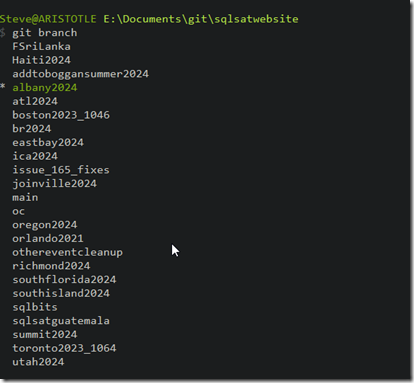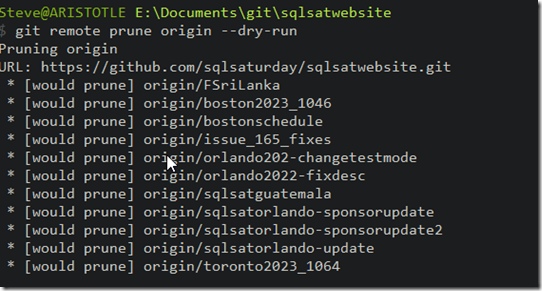As I’ve been working with SQL Saturday and managing changes to events, I’ve accumulated a lot of branches. Even though I’m a solo developer, I decided to use branches, as I expect others to share this load in the future. This post looks at how to start cleaning those up.
Another post for me that is simple and hopefully serves as an example for people trying to get blogging as #SQLNewBloggers. You can see all posts on Git as well.
Another post for me that is simple and hopefully serves as an example for people trying to get blogging as #SQLNewBloggers.
Finding Old Branches
When I ran the git branch command, I saw this. There are a lot of old branches in there.
I decided that I should reduce this number. After all, even removing stale branches means I have a lot of events in flight.
We use GitHub, and when I go on the site, I see lots of branches, some of which date back to last year. Those events are done, so I decided to delete some branches. In the image below, there are three branches. To the right, there are delete icons on the bottom two as I’ve already pressed the one to delete the remote branch on the top one.
Now, how do I delete the local branch? Let’s start by removing it.
Git Prune
There is a command to remove references to remote branches that are deleted: git prune. I deleted a few older branches, and then ran git prune for remotes, with the –dry-run option. This tells me what would happen. As you can see, a number of branch references would be deleted.
Nothing in here I’m worried about or that is active. I’ve deleted these on GitHub, so I’ll re-run the command without dry run. This removes the references.
Unfortunately, the local branches still exist. We don’t remove these, as it’s possible I have work on a local branch not sent to the remote, so doing this automatically, even if I do it, is dangerous.
I’ll do another post on removing the local branches.
Automating the Removal of Remote references
I might want to remove local references for branches that get deleted on the remote. This is useful if you delete branches on merge. I don’t in this case, as I’m often using the same branch for multiple changes for an event, rather than a new branch for every one.
One way to do this is to change the config with this:
git config remote.origin.prune true
This will then run the prune on each fetch or full. This helps keep things cleaner, though local branches still exist. However, if I commit to a local branch and push, I’ll get an error that I need to configure the upstream. That helps with me being aware of what’s active or not.
SQL New Blogger
Using version control is a core skill for anyone in technology. Even database people. You could write posts on how you use or learn about git (or something else) and showcase your skills.
This post took me about 15 minutes to write, even with screen shots.




